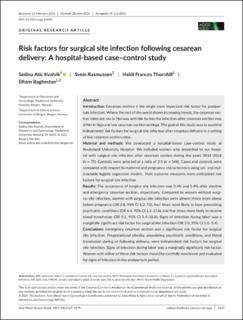| dc.contributor.author | Kvalvik, Sedina Atic | |
| dc.contributor.author | Rasmussen, Svein | |
| dc.contributor.author | Thornhill, Heidi Frances | |
| dc.contributor.author | Baghestan, Elham | |
| dc.date.accessioned | 2022-04-20T10:59:41Z | |
| dc.date.available | 2022-04-20T10:59:41Z | |
| dc.date.created | 2021-10-15T20:28:22Z | |
| dc.date.issued | 2021 | |
| dc.identifier.issn | 0001-6349 | |
| dc.identifier.uri | https://hdl.handle.net/11250/2991595 | |
| dc.description.abstract | Introduction
Cesarean section is the single most important risk factor for postpartum infection. Where the rest of the world shows increasing trends, the cesarean section rates are low in Norway and risk factors for infection after cesarean section may differ in high and low cesarean section settings. The goal of this study was to examine independent risk factors for surgical site infection after cesarean delivery in a setting of low cesarean section rates.
Material and methods
We conducted a hospital-based case-control study at Haukeland University Hospital. We included women who presented to our hospital with surgical site infection after cesarean section during the years 2014–2016 (n = 75). Controls were selected at a ratio of 2:1 (n = 148). Cases and controls were compared with respect to maternal and pregnancy characteristics using uni- and multivariable logistic regression models. Main outcome measures were anticipated risk factors for surgical site infection.
Results
The occurrence of surgical site infection was 0.4% and 5.4% after elective and emergency cesarean section, respectively. Compared to women without surgical site infection, women with surgical site infection were almost thrice more obese before pregnancy (OR 2.8, 95% CI 1.2–7.0), four times more likely to have preexisting psychiatric conditions (OR 4.4, 95% CI 1.1–17.6), and five times more likely to receive blood transfusion (OR 5.1, 95% CI 1.4–18.8). Signs of infection during labor was a marginally significant risk factor for surgical site infection (OR 2.0, 95% CI 1.0–5.4).
Conclusions
Emergency cesarean section was a significant risk factor for surgical site infection. Pregestational obesity, preexisting psychiatric conditions, and blood transfusion during or following delivery, were independent risk factors for surgical site infection. Signs of infection during labor was a marginally significant risk factor. Women with either of these risk factors should be carefully monitored and evaluated for signs of infection in the postpartum period. | en_US |
| dc.language.iso | eng | en_US |
| dc.publisher | Wiley | en_US |
| dc.rights | Attribution-NonCommercial-NoDerivatives 4.0 Internasjonal | * |
| dc.rights.uri | http://creativecommons.org/licenses/by-nc-nd/4.0/deed.no | * |
| dc.title | Risk factors for surgical site infection following cesarean delivery: A hospital-based case–control study | en_US |
| dc.type | Journal article | en_US |
| dc.type | Peer reviewed | en_US |
| dc.description.version | publishedVersion | en_US |
| dc.rights.holder | Copyright 2021 The Author(s) | en_US |
| cristin.ispublished | true | |
| cristin.fulltext | original | |
| cristin.qualitycode | 1 | |
| dc.identifier.doi | 10.1111/aogs.14235 | |
| dc.identifier.cristin | 1946344 | |
| dc.source.journal | Acta Obstetricia et Gynecologica Scandinavica | en_US |
| dc.source.pagenumber | 2167-2175 | en_US |
| dc.identifier.citation | Acta Obstetricia et Gynecologica Scandinavica. 2021, 100 (12), 2167-2175. | en_US |
| dc.source.volume | 100 | en_US |
| dc.source.issue | 12 | en_US |

